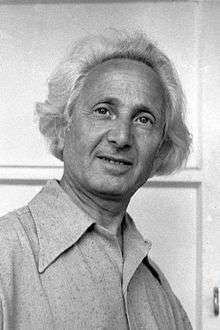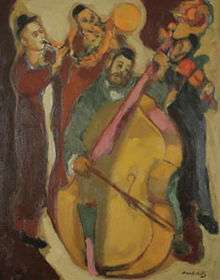Emmanuel Mane-Katz
Emmanuel Mané-Katz (Hebrew: מאנה כץ), born Mane Leyzerovich Kats (1894–1962), was a Litvak[1] painter born in Kremenchuk, Ukraine, best known for his depictions of the Jewish shtetl in Eastern Europe.[2]


Biography
Mane-Katz moved to Paris at the age of 19 to study art,[3] although his father wanted him to be a rabbi. During the First World War he returned to Russia, at first working and exhibiting in Petrograd; following the October revolution, he traveled back to Kremenchuk, where he taught art.[3] In 1921, due to the ongoing fighting in his hometown during the civil war, he moved once again to Paris.[3] There he became friends with Pablo Picasso and other important artists, and was affiliated with the art movement known as the School of Paris;[3] together with other outstanding Jewish artists of that milieu, he is sometimes considered to be part of a group referred to specifically as the Jewish School of Paris.[4]
In 1931, Mane-Katz's painting The Wailing Wall was awarded a gold medal at the Paris World's Fair.[3]
Early on, his style was classical and somber, but his palette changed in later years to bright, primary colors, with an emphasis on Jewish themes. His oils feature Hassidic characters, rabbis, Jewish musicians, beggars, yeshiva students and scenes from the East European shtetl.[5]
Mane-Katz made his first trip to Mandate Palestine in 1928, and thereafter visited the country annually. He said his actual home was Paris, but his spiritual home was Eretz Yisrael, the Land of Israel.
Mane-Katz museum
Mane-Katz left his paintings and extensive personal collection of Jewish ritual art to the city of Haifa, Israel.[3] Four years before his death, the mayor of Haifa, Abba Hushi, provided him with a building on Mt. Carmel to house his work, which became the Mane-Katz Museum. The exhibit includes Mane-Katz's oils, showing a progressive change in style over the years, a signed portrait of the artist by Picasso dated 1932 and a large collection of Jewish ritual objects.
In 1953, Mane-Katz donated eight of his paintings to the Glitzenstein Museum in Safed, whose artists quarter attracted leading Israeli artists in the 1950s and 1960s, and housed some of the country's most important galleries.[2]
Further reading
- Aimot, J. Mane-Katz. 1933
- Ragon, M. Mane-Katz. 1961
- Werner, A. Mane-Katz. 1960
References
- "Exhibition 'Hello, Paris! The Path of Litvak Artists'" (January 1, 2014). Lewben Art Foundation. lewbenart.com. Retrieved 2016-12-21.
- Ashkenazi, Eli (September 28, 2008). "An Inside Job?". Haaretz.com. Retrieved 2016-12-21.
- Werner, Alfred (2007). "Mane-Katz." Encyclopaedia Judaica. 2nd ed. Macmillan Reference USA. Retrieved via Biography in Context database, 2016-12-21. See also: 1st edition. Jerusalem: Keter Publishing, 1972. Vol. 11, p. 870-871.
- Schechter, Ronald; Zirkin, Shoshannah (2009). "Jews in France". In: M. Avrum Ehrlich (Ed.), Encyclopedia of the Jewish Diaspora: Origins, Experiences, and Culture. Santa Barbara, Calif.: ABC-CLIO. ISBN 9781851098736. Vol. 3. p. 820-831; here: p. 829.
- http://goliath.ecnext.com/coms2/summary_0199-3096279_ITM
External links
| Wikimedia Commons has media related to Mane Katz. |